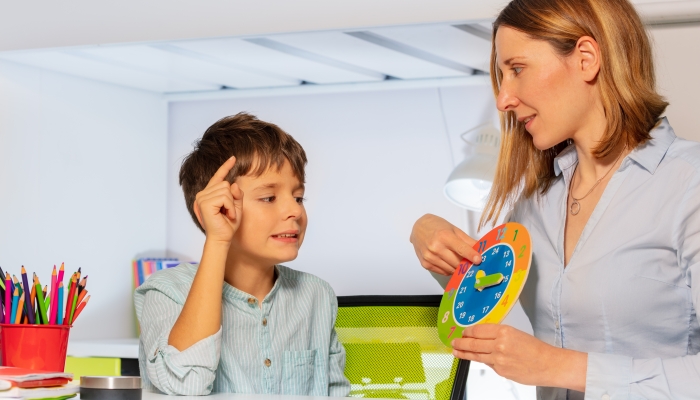How to Deal With Sensory Overload in Children

- Sensory overload can happen when your child is exposed to more sensory input—including sight, sound, smell, touch, movement, and taste—than their brain can process.
- While more common in children with autism spectrum disorder or a sensory processing disorder, anyone can experience sensory overload.
- Symptoms of sensory overload vary depending on the child and the situation, but it typically triggers a freeze, fight, or flight response.
- Parents can teach their children skills to manage the symptoms of sensory overload.
- Working with an occupational therapist or behavior analyst can help with treating sensory overload in children.
Every day, we’re constantly taking in sensory input from the world around us. For a child, this can add up to a lot of new information to process—from new sights and sounds to sometimes unpleasant smells, tastes, and textures. At times, children’s brains can have a hard time making sense of all of this sensory input, which can lead to sensory overload.
While anyone can experience sensory overload, it can be especially overwhelming for young children. This may lead to behaviors that interfere with daily life or even potentially put the child in danger. They might shut down, have an emotional outburst, or try to run from the situation.
Fortunately, by learning how to deal with sensory overload, you can help your child manage their symptoms and even prevent future meltdowns.
What Is Sensory Overload?
Sensory overload is when a person is unable to process all of the sensory input they’re experiencing. It’s also sometimes referred to as sensory defensiveness or overstimulation.
“Sensory overload, or overstimulation, occurs when an individual experiences an overabundance of sensory stimulation at one time,” says Melissa Schiefelbein, teacher, certified behavior analyst, and the founder and CEO of Bloom Health. “Any or all of the senses can be involved in sensory overload, and it may or may not be an indication of autism spectrum disorder or a related form of neurodivergence.”
Renee Rosales M.Ed, founder and CEO of Theara, says that experiencing sensory overload can be frightening for children. “For anyone experiencing this it can be overwhelming, and this is especially true of children who are still learning to regulate their emotions,” says Rosales. “Sensory overload is a common occurrence among those who are neurodiverse and can be particularly frightening for neurodiverse children.”

Sensory Overload Symptoms
According to Dr. Lauren Starnes, senior vice president and chief academic officer at The Goddard School, the symptoms of sensory overload vary depending on the child and the situation.
“Sensory overload usually first appears with a ‘deer in the headlights’ look as the child attempts to make sense of all the sensory input,” says Starnes, adding that you could see any (but not necessarily all) of the following symptoms:
- An overexcited degree of energy
- Difficulty concentrating
- Difficulty answering questions or completing routine tasks
- Covering eyes or ears
- Physiological responses like vomiting, sweating, rapid shallow breathing, or tremors
- Resisting touch
- Angry tantrum-like outbursts
Dr. Chandra Foote, professor and dean of the College of Education at Niagara University, says that there are three types of responses to sensory overload: freeze, fight, or flight.
“Just as there are individual differences in susceptibility to sensory overload, people respond in different ways when they experience it,” says Foote. “Some people shut down. In this example a child might tuck into a fetal position, suck on a thumb, or rock in a soothing manner.”
“Alternatively, a person might respond to sensory overload in an explosive manner such as flailing arms, running in circles, punching, jumping, or large-scale repetitive movements like banging their head on a wall. At other times, individuals respond by running from the situation, which can be extremely dangerous because they are not attentive to potential hazards like running into on-coming traffic.”
Keep in mind that your child may not always have the same response to sensory overload. “It is important to note that a person experiencing sensory overload might behave differently from one experience to the next,” says Foote.
Sensory Overload Causes
Anyone can experience sensory overload when exposed to a lot of sensory stimuli, especially young children. According to Starnes, sensory overload can happen in any situation, but it’s common when children are experiencing a lot of sensory input at once, like at a birthday party.
“You may also see young children have sensory overload in initial exposure to movies, at amusement parks, in busy or crowded places, or at sporting events,” says Starnes. “Any situation where the child has exposure to lots of sensory input—sight, sound, smell, touch, movement, and taste—can trigger sensory overload.”
While having a sensory meltdown isn’t necessarily a sign of a sensory processing disorder or autism spectrum disorder, sensory overload is often seen in children with autism or sensory processing issues.
“Sensory overload occurs very commonly on the spectrum,” says Schiefelbein, “because an individual with autism experiences areas of the brain that are more active than a neurotypical individual, which creates sensory defensiveness. This means that an individual on the spectrum can experience sounds, sights, smells, and textures differently, and at a greater magnitude.”
Chana M. Geldzahler, an applied behavior analysis (ABA) therapist for children, says that a child may be more likely to experience sensory overload if they’re tired, hungry, thirsty, hot, cold, or ill. “In those cases, the child might reach the point of sensory overload sooner than they would if those factors weren’t present,” says Geldzahler.

How to Avoid and Manage Sensory Overload in Children
Fortunately, there are some strategies you can use to avoid sensory overload in children. This may include limiting or planning ahead for triggers as well as teaching your child ways to cope with overwhelming sensory stimuli.
Here are some steps to take if you think your child is experiencing sensory overload.
Be aware of the environment.
First, it’s important for you as the parent to be aware of the the environment and your child’s response to it, says Foote. “When the child is not responding as he or she normally would, it is important to survey the surroundings. Is there a helicopter flying overhead? Is there a strange smell? Is there just too much going on at once?”
For younger children, it’s sometimes best to remove them from an overstimulating situation in order to prevent a full-blown meltdown, explains Foote. Then, once you’re aware of your child’s sensitivity, you can help to gradually expose them to stimuli in a more controlled environment, a process called chaining. “We can think of chaining as wading in slowly versus being pushed into the deep end.”
Be prepared for overstimulation.
While you can’t always avoid the stimuli in their environment, Schiefelbein says you can teach your child skills to help them manage their symptoms on their own.
She recommends the following helpful tips to manage sensory overload:
- Allow your child to use headphones to limit auditory stimuli and block out loud noises.
- Keep sunglasses available to control visual stimulation if bright lights or flashing lights make your child feel overwhelmed.
- Teach your child a communication system, so they can quickly let you know when they’re overstimulated.
- Use social stories or visual cues to prepare your child for a situation with sights, sounds, and smells that could lead to overstimulation.
- Have a comfortable “safe space” or sensory room for when they’re feeling overstimulated, which may have soft textures, sensory toys, dim lighting, and limited sound.
Having these tools available can help your child to handle situations that might normally lead to sensory overload.
Familiarize your child with their senses.
Miriam Frankel (formerly Manela), occupational therapist, author of The Parent-Child Dance, and the founder and director of the online learning platform Bloom, stresses the importance of using a gentle approach to manage sensory overload, especially for children with sensory processing disorders.
“When you have a child that has sensory information that’s not coming in properly, you have behavior that doesn’t come out properly,” says Frankel. “This is why parenting or teaching a child with SPD can be so challenging—because you are dealing with behaviors that are extremely difficult to manage.”
Frankel says that a child’s behavior may look like defiance, disrespect, fussiness, or aggression, but they’re responding to a “mishap” in the brain that’s causing their intense feelings. If you’re dealing with sensory overload and not simply a strong-willed toddler, disciplining your child won’t get to the root of the problem.
Instead, try calming or stimulating sensory activities to prevent sensory overload, while helping them to feel safe and loved. Along with other activities available in Bloom’s online toolkits, Frankel recommends the following:
Brushing with a natural bristle brush, towel, or coarse terry cloth.
Help your child feel in control by telling them what you will be doing and allowing them to choose the speed of brushing. With medium pressure, brush the hands, arms, neck, face, legs, back, and belly.
Hand hugs.
“Cup your palms so that they both fit snugly, but gently around the limb that you are working with at the time,” says Frankel. “Your fingers may be interlaced or overlapping. Give firm but gentle, loving ‘hugs.’ Squeeze gently around at least three or four places on the forearm or leg.”
Tactile boxes.
Also called sensory bins or sensory tables, these are boxes filled with various items with different textures. Sponges, brushes, sandpaper, and water beads are all great options. Frankel recommends trying some activities with a tactile box, like having your child close their eyes and guess which item they’re holding.
“These three tools help to familiarize the child with their senses in a calm way at a pace that feels less threatening to them,” says Frankel. “Eventually, this will show the child that sensations are ‘not all that evil after all.’”
Treating Sensory Overload in Children
If you’re struggling to minimize sensory overload on your own, working with a board certified behavior analyst (BCBA) or an occupational therapist can help with treating sensory issues.
“Collaborate with an occupational therapist to create a ‘sensory diet’ that will help the child with sensory processing and reduce overstimulation,” says Geldzahler, who works as an ABA therapist for kids.
A sensory diet is a plan of sensory activities designed for a child’s individual sensory needs. It might include activities like swinging on a sensory swing or playing with fidget toys. Sensory toys for autism and sensory toys for visually impaired kids can also be used as part of a sensory diet.
Working with a BCBA can also help a child that experiences sensory overload to tolerate sensory inputs and minimize sensory overload. “Contact a BCBA to help create a target for systematic desensitization,” says Schiefelbein, “which is a program that slowly, systematically, and safely teaches a child to tolerate stimuli in a way that uses high levels of support, praise, and reinforcement.”
Schiefelbein adds that a BCBA can help to identify your child’s triggers and teach them ways to work through sensory overload before it progresses.
All of these tools can help to teach you and your child how to deal with sensory overload together. It may just take some trial and error—and a lot of patience—for you to find what works best for your child.

Related Posts

Autism
Developing Time Management Skills in Children with Autism: 7 Tips
Learn how you can use structure and visual aids to help your child with autism learn time management skills.

Autism
Occupational Therapy for Children with Autism: How It Can Make a Difference
Children with autism face challenges in many different areas. Occupational therapy can help children address these difficulties while having fun!

Behavior
Understanding Intermittent Explosive Disorder in Children
Are you worried about your child’s unexpected aggression and explosive behaviors? Learn how to support a child with intermittent explosive disorder.